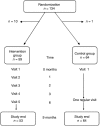Self-monitoring of blood glucose in type 1 diabetes patients with insufficient metabolic control: focused self-monitoring of blood glucose intervention can lower glycated hemoglobin A1C
- PMID: 20046652
- PMCID: PMC2769849
- DOI: 10.1177/193229680900300109
Self-monitoring of blood glucose in type 1 diabetes patients with insufficient metabolic control: focused self-monitoring of blood glucose intervention can lower glycated hemoglobin A1C
Abstract
Objective: Little attention has been given and few studies have been published focusing on how to optimize self-monitoring of blood glucose (SMBG) use to monitor daily therapy for persons with type 1 diabetes mellitus. This study was designed to evaluate the effect on glycated hemoglobin (A1C) of a structured intervention focused on SMBG in type 1 diabetes patients with insufficient metabolic control (A1C ≥8%) using a randomized clinical trial design.
Method: One hundred fifty-nine outpatients with type 1 diabetes on multiple injection therapy with insulin and A1C ≥8% were recruited and randomized to one group receiving a focused, structured 9-month SMBG intervention (n=59) and another group receiving regular care based on guidelines (n=64).
Results: Glycated hemoglobin values (mean % ± standard deviation) at study start was similar: 8.65 ± 0.10 in the intervention group and 8.61 ± 0.09 in the control group. The two groups were comparable (age, gender, body mass index, complication rate, and treatment modality) at study start and had mean diabetes duration and SMBG experience of 19 and 20 years, respectively. At study end, there was decrease in A1C in the intervention group (p<.05), and the A1C was 0.6% lower compared with the control group (p<.05). No increase in the number of minor or major hypoglycemia episodes was observed in the intervention group during the study period.
Conclusions: A simple, structured, focused SMBG intervention improved metabolic control in patients with longstanding diabetes type 1 and A1C ≥8%. The intervention was based on general recommendations, realistic in format, and can be applied in a regular outpatient setting.
Keywords: A1C; glycemic control; self-monitoring of blood glucose; type 1 diabetes.
© Diabetes Technology Society
Figures
References
-
- Drash A. The control of diabetes mellitus: is it achievable? Is it desirable? J Pediatr. 1976;88(6):1074–1076. - PubMed
-
- Siperstein MD, Foster DW, Knowles HC, Levine R, Madison LL, Roth J. Control of blood glucose and diabetic vascular disease. N Engl J Med. 1977;296(18):1060–1063. - PubMed
-
- Sönksen PH, Judd SL, Lowy C. Home monitoring of blood-glucose. Method for improving diabetic control. Lancet. 1978;1(8067):729–732. - PubMed
-
- Walford S, Gale EA, Allison SP, Tattersall RB. Self-monitoring of blood-glucose. Improvement of diabetic control. Lancet. 1978;1(8067):732–735. - PubMed
Publication types
MeSH terms
Substances
LinkOut - more resources
Full Text Sources
Medical




